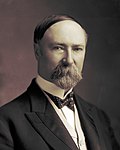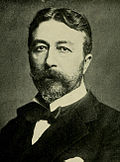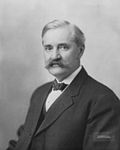1908 Republican National Convention
This article needs additional citations for verification. (January 2017) |
| Ballots | 1 |
|---|---|
The 1908 Republican National Convention was held in
The Platform

The Republican platform celebrated the Roosevelt administration's economic policies such as the keeping of the protective tariff, establishment of a permanent currency system (the
In foreign policy, it supported a buildup of the armed forces, protection of American citizens abroad, extension of foreign commerce, vigorous arbitration and the Hague treaties, a revival of the
In other areas, it advocated court reform, creation of a federal Bureau of Mines and
The platform lastly expressed pride in U.S. involvement in the building of the
Speakers

The following individuals spoke at the 1908 Republican National Convention. Many spoke with the goal of nominating a specific nominee as this was before the age of the primary and the nominees were all decided at the convention.
June 16
- Prayer by Rt. Rev. P.J. Muldoon V.G.
- Julius C. Burrows, Michigan Senator
June 17
- Prayer by Rev. William Otis Waters
- Henry Cabot Lodge, Massachusetts Senator
June 18
- Prayer by Rev. Dr. John Wesley Hill
- George Henry Williams, Former Attorney General
- Henry Sherman Boutell of Illinois, Lawyer and diplomat
- Joseph W. Fordney, Congressman of Michigan
- Frank Hanly, Governor of Indiana
- Charles A. Bookwalter, Mayor of Indianapolis
- Stewart L. Woodford, Former Congressman and Judge of New York
- Theodore E. Burton, Congressman of Ohio
- George A. Knight, Attorney and Businessman
- C. B. M'Coy, Ohio Factory Owner
- W. O. Emory, Young Black Delegate from Macon, Georgia
- Robert S. Murphy, Lieutenant Governor of Pennsylvania
- James Scarlet, Prominent Attorney from Danville, Pennsylvania
- Henry F. Cochems, Wisconsin Football Star
- Charles A. A. McGee, Author of "The Truth About Money" from Wisconsin
June 19
- Prayer by Rabbi Tobias Schanfarber
- Timothy L. Woodruff, Businessman and Former Politician
- Joseph Gurney Cannon, Speaker of the House
- Augustus E. Willson, Governor of Kentucky
- Henry Cabot Lodge (again)
- Chase Osborn of Michigan
- James Brownlow Yellowley, Mississippi State Legislator
- Thomas N. McCarter, Former Attorney General of New Jersey and public servant
- William Warner, Senator from Missouri
- Julius C. Burrows of Michigan
Presidential nomination
Presidential candidates
-
Robert M. La Follette
of Wisconsin
The Republicans faced difficulties selecting a successor to Roosevelt. Elihu Root was favored by Roosevelt, but his age and alignment with corporations made him unpalatable.[1][2] Prior to the convention, Vice President Charles W. Fairbanks and New York Governor Charles Evans Hughes both seemed like plausible nominees, but Roosevelt was determined to pick his own successor.[3] U.S. Senator Joseph B. Foraker sought the nomination and was financed by Winthrop M. Crane and Henry Cabot Lodge.[4]
Roosevelt supported Secretary of War William Howard Taft.[2] Entering the convention, Taft, buoyed by the support of the popular Roosevelt, was virtually assured of the nomination.[5] U.S. Senator Jacob H. Gallinger was among the supporters of a movement to stop Taft's nomination.[4] Taft won the presidential nomination on the first ballot, overcoming Fairbanks and the other favorite son candidates.[6]
Withdrew Before Convention
Declined to Seek Nomination
| Presidential Balloting | ||
|---|---|---|
| Candidate | 1st | Unanimous |
| Taft | 702 | 980 |
| Knox | 68 | |
| Hughes | 67 | |
| Cannon | 58 | |
| Fairbanks | 40 | |
| La Follette | 25 | |
| Foraker | 16 | |
| Roosevelt | 3 | |
| Not Voting | 1 | |
Presidential Balloting / 3rd Day of Convention (June 18, 1908)
-
1st Presidential Ballot
Vice Presidential nomination
Vice Presidential candidates
-
Curtis Guild, Jr.
of Massachusetts -
(Not Nominated)
Taft preferred a progressive running mate such as Indiana Senator
Declined to Seek Nomination
| Vice Presidential Balloting | ||
|---|---|---|
| Candidate | 1st | Unanimous |
| Sherman | 816 | 980 |
| Murphy | 77 | |
| Guild | 75 | |
| Sheldon | 10 | |
| Fairbanks | 1 | |
| Not Voting | 1 | |
Vice Presidential Balloting / 4th Day of Convention (June 19, 1908)
-
1st
Vice Presidential Ballot
See also
- History of the United States Republican Party
- List of Republican National Conventions
- United States presidential nominating convention
- 1908 United States presidential election
- 1908 Democratic National Convention
References
- ^ Mowry 1960, p. 29.
- ^ a b c d "James S. Sherman, 27th Vice President (1909–1912)". US Senate. Retrieved 8 October 2015.
- ^ "Charles Warren Fairbanks, 26th Vice President (1905–1909)". US Senate. Retrieved 9 October 2015.
- ^ a b Mowry 1960, p. 30.
- ^ "Convention on, Taft Controls". New York Times. 17 June 1908. Retrieved 8 October 2015.
- ^ "Taft Named; First Ballot". New York Times. 19 June 1908. Retrieved 8 October 2015.
- ^ Curtis, Charles. In His Own Words. Kansas State Historical Archives.
- ^ a b Tweedy, John (1910). A History of the Republican National Conventions from 1856 to 1908. Republican National Convention. pp. 389–390. Retrieved 8 October 2015.
Works cited
- Mowry, George (1960). Theodore Roosevelt and the Progressive Movement. University of Wisconsin Press.
External links
- Republican Party platform of 1908 at The American Presidency Project
- Taft acceptance speech at The American Presidency Project
| Preceded by Chicago, Illinois
|
Republican National Conventions | Succeeded by Chicago, Illinois
|





















